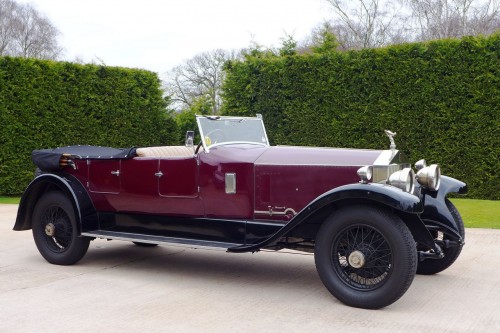
Click Here for Full Screen Image - Click Here to Download Image
 |  |  |  |  | |||||
 |  |  |  |  | |||||
 |  |  |  |  | |||||
 |  |  |  |  |
| Lot number | 161 |
|---|---|
| Hammer value | N/S (est. £120,000 - £140,000) |
| Description | Rolls-Royce Phantom I Tourer |
| Registration | UL 5136 |
| Year | 1928 |
| Colour | Maroon/Black |
| Engine size | 5,648 cc |
| Chassis No. | 55CL |
| Engine No. | XG75 |
Widely regarded as ‘the best car in the world’ the 40/50 Silver Ghost, was going to be a very hard act to follow.
Introduced in 1906 and remaining in production largely unchanged until 1925 (after which it was still available to special order), what really set it apart was the perfection of its engineering, only possible due to its post-WW1 'chassis only' price of £1,850, a colossal sum at a time when a labourer’s weekly wage was about £2 and a decent family home cost about £500.
A relatively conventional design, it used side-by-side valves, cantilever rear springs and a separate gearbox. By 1924 even Rolls-Royce had to admit that its more sophisticated competition was starting to affect sales, not that they could rival the Ghost's silence and quality. Hispano Suiza in particular, who had a similar aeronautical background gained from the war effort, were offering more glamorous and better performing products.
From this point Rolls-Royce offered the Ghost with front wheel brakes, built under licence from Hispano Suiza, realising that a more substantial list of improvements would be required. Given the speed of automotive development in this period, it is testament to the original design and sheer quality of build that the 40/50 Silver Ghost remained in production at the top of the tree for 19 years.
In 1925 the ‘New Phantom’ was unveiled. Using the same chassis as the Ghost, the new 40/50 featured an all new engine with pushrod operated overhead valves located in two individual blocks of three cylinders with a single detachable head. Looking like an enlarged 20hp unit, great care was taken to silence the valve actuation, a complex task which had held off such developments previously. The stroke was increased to 139.7mm delivering more torque, while the bore was decreased slightly to 107.9mm giving a capacity of 7,668cc.
Although Rolls-Royce famously never stated their engine power outputs, merely quoting that they were sufficient for the task in hand, it is thought that they produced around 100bhp at their stated maximum engine revolutions of 2,750rpm. On the road however, they would happily rev to over 3,000rpm and whisk most touring-bodied Phantoms to well over 80mph.
The rest of the car remained much the same (although gaining an enclosed clutch and the distinctive shuttered radiator), production totalling some 2,212 Derby-built chassis by 1929 when the Phantom II was introduced (a further 1,241 chassis also being built in Springfield, Massachusetts, for the lucrative American market), the New Phantom being referred to as the Phantom I from then on.
Chassis number 55CL left the Derby works in October 1928 and was first owned by a Scottish customer who had it fitted with saloon coachwork by Wilkinson & Sons of Derby. Notes in the history file suggest that it was later used as a hearse before seeing service in WW2 as an ambulance, after which it was put into storage in a barn near Cannock, Staffordshire, where it was to remain for many years.
In the early 1970s the car was rescued from storage by a Mr Bloor and fully restored with new tourer coachwork by Restor of Derby, an old green log book showing that it was back on the road in May 1974 and registered to JS Bloor Ltd (leading your cataloguer to wonder if its saviour may have been John Stuart Bloor of Swadlincote, the business magnate who founded Bloor Homes and went on to revive Triumph Motorcycles in 1991 with a cash injection of £80m?).
It was next owned by a Mr M Aspinal and then Mr M Astbury of Cannock from whom Mr J Marsh of Stourbridge (of Marsh & Baxter Butchers fame) acquired it in 1985. Mr Marsh was to keep the car for the next 30 years until he passed away recently, using the car regularly including numerous Continental tours, a photo in the history file showing the car bowling happily through Switzerland on one such jaunt.
Various bills show regular upkeep throughout Marsh’s ownership, the most significant being a full engine rebuild in September 1996 by Cliff Long Engineering of Kinver, since when the car has clocked up some 34,500 miles, an average of around 1,800 miles per year and testament to the thoroughly usable nature of this 87-year-old machine. Still in fine running order today, it fired up instantly and ran beautifully as we manoeuvred it for these pictures.
The car comes with a full set of weather gear including hood, hood bag and two tonneau covers (allowing half and full coverage of the interior), all in excellent condition, plus tools, wheel changing kit and an owner’s instruction manual. Altogether a wonderfully preserved motorcar, from long-term enthusiast ownership, which is ready for a new custodian to enjoy right away.